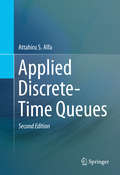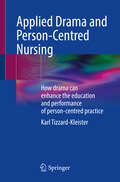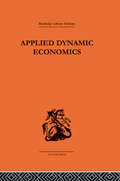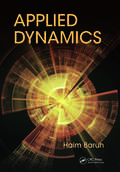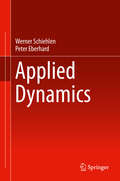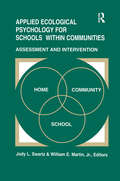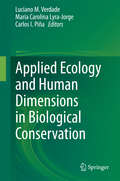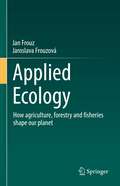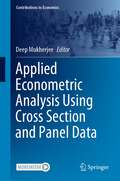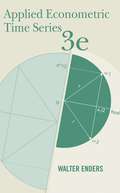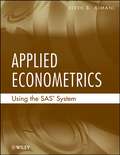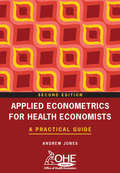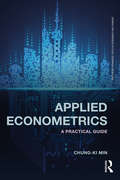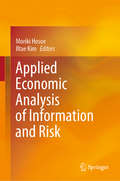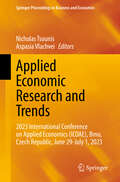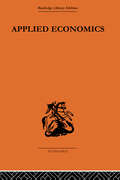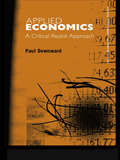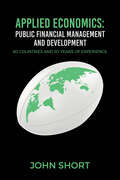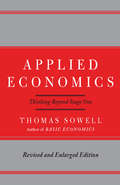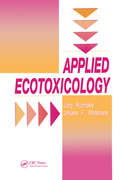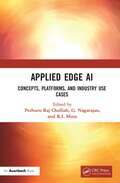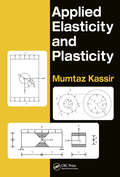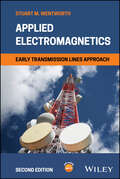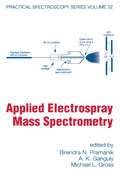- Table View
- List View
Applied Discrete-Time Queues
by Attahiru S. AlfaThis book introduces the theoretical fundamentals for modeling queues in discrete-time, and the basic procedures for developing queuing models in discrete-time. There is a focus on applications in modern telecommunication systems. It presents how most queueing models in discrete-time can be set up as discrete-time Markov chains. Techniques such as matrix-analytic methods (MAM) that can used to analyze the resulting Markov chains are included. This book covers single node systems, tandem system and queueing networks. It shows how queues with time-varying parameters can be analyzed, and illustrates numerical issues associated with computations for the discrete-time queueing systems. Optimal control of queues is also covered. Applied Discrete-Time Queues targets researchers, advanced-level students and analysts in the field of telecommunication networks. It is suitable as a reference book and can also be used as a secondary text book in computer engineering and computer science. Examples and exercises are included.
Applied Drama and Person-Centred Nursing: How drama can enhance the education and performance of person-centred practice
by Karl Tizzard-KleisterThis ground-breaking book highlights and extends on the increasing number of research and practice collaborations between the disciplines of drama and nursing across the globe. Uniquely, it presents how drama-based interactive education can enable nursing students to develop an embodied understanding of sympathetic presence within a person-centred curriculum. This text provides meaningful insights into how to cultivate approaches to be person-centred and sympathetically present in every interaction with others through the application of drama-based methods. The work described within seeks to show how applying drama can help people perform more effective person-centred practices, with applied drama approaches which are in turn more person-centred.By focusing on the author’s innovative doctoral research study, this book seeks to show how taking part in expertly designed drama practice alongside nursing education leads nurses towards engaging more in person-centredness, overcoming their personal vulnerabilities, showing an enhanced ability to attend to others, and a greater understanding of how to perform presence. Meanwhile showing applied drama practitioners how they can understand facilitation practice through sympathetic presence to discover practical ways to approach an aesthetics of care in their practice.This book offers a process for nurse educators and applied drama artists to work together in a mutual exchange, where both fields can contribute specialised expertise in developing the next generation of person-centred practitioners.
Applied Dynamic Economics (Routledge Library Editions)
by Kenneth K. KuriharaCollecting together papers from international journals, this book encompasses economics and the philosophical, historical, technical and practical facets of the real world. Grouped together in three separate, yet related parts, the essays deal with 'Problems of Developed Economies', 'Problems of Developing Economies' and 'International Prosperity and Progress'. Reviews of relevant books by Roy Harrod, T. Haavelmo, W. A. Lewis and T. Barna have been included as appendices. Truly international in its coverage and sources, this collection includes articles from the USA, Japan, the UK, India, Italy, Switzerland and Jamaica.
Applied Dynamics
by Haim BaruhGain a Greater Understanding of How Key Components WorkUsing realistic examples from everyday life, including sports (motion of balls in air or during impact) and vehicle motions, Applied Dynamics emphasizes the applications of dynamics in engineering without sacrificing the fundamentals or rigor. The text provides a detailed analysis of the princi
Applied Dynamics (CISM International Centre for Mechanical Sciences #507)
by Werner Schiehlen Peter EberhardApplied Dynamics is an important branch of engineering mechanics widely applied to mechanical and automotive engineering, aerospace and biomechanics as well as control engineering and mechatronics. The computational methods presented are based on common fundamentals. For this purpose analytical mechanics turns out to be very useful where D'Alembert's principle in the Lagrangian formulation proves to be most efficient. The method of multibody systems, finite element systems and continuous systems are treated consistently. Thus, students get a much better understanding of dynamical phenomena, and engineers in design and development departments using computer codes may check the results more easily by choosing models of different complexity for vibration and stress analysis.
Applied Ecological Psychology for Schools Within Communities: Assessment and Intervention
by William E. Martin Jody L. SwartzThis volume provides a thorough examination of the interplay between individuals and their environment in the development and maintenance of problem behaviors, and delineates procedures for conducting assessment, intervention, and prevention within the child's ecosystem. As individuals structure, change, and organize their environments, their environments work to do the same. Environmental or contextual and individual variables act reciprocally to shape an individual's behavior. For school-aged youth, this reality necessitates an ecological approach to assessment, intervention, and prevention. Specifically, problem behaviors are partly developed and maintained by a combination of factors present in the child's psychosocial ecosystem -- home, school, and community. Although there is an abundance of theoretical applications and research supporting this concept, the predominant trend has been to emphasize the properties of the person. As a result, one is left to assume that the genesis of difficulties in adaptation lies in internal or personal states and traits of the individual. In contrast to traditional psychology theories which focus primarily on the individual, incorporation of ecological psychology concepts allows for a more comprehensive and in-depth analysis of sources contributing to the individual's ability to adapt to their psychosocial environment. Ecological theories which drive assessment, intervention, and prevention efforts provide the necessary framework for assisting school-aged youth and their associated ecological networks to cope with and overcome the multidetermined, multifaceted concerns that arise during the school years. However, this is an often difficult and cumbersome task for educators, parents, and school systems to undertake. To this end, this volume focuses on the functional application of ecological psychology for schools within communities. Each of the 10 chapters -- written by key figures in school, family, counseling, and community psychology -- explores the use of ecological theory from a different perspective, ranging from focus on the child, the child within the classroom, the classroom teacher, and the community to considerations in working with special populations such as juvenile delinquents and in planning for developmental issues such as school-to-work-transition. The final chapter summarizes and integrates the previous chapters and provides suggestions for future directions in the field.
Applied Ecology and Human Dimensions in Biological Conservation
by Luciano M. Verdade Maria Carolina Lyra-Jorge Carlos I. PiñaThis book provides both the conceptual basis and technological tools that are necessary to identify and solve problems related to biodiversity governance. The authors discuss intriguing evolutionary questions, which involve the sometimes surprising adaptive capacity of certain organisms to dwell in altered and/or changing environments that apparently lost most of their structure and functionality. Space and time heterogeneities are considered in order to understand the patterns of distribution and abundance of species and the various processes that mold them. The book also discusses at which level--from genes to the landscape, including individuals, populations, communities, and ecosystems--men should intervene in nature in order to prevent the loss of biodiversity.
Applied Ecology: How agriculture, forestry and fisheries shape our planet
by Jan Frouz Jaroslava FrouzováThis book offers a comprehensive introduction to basic ecological and biological principles underlying modern agriculture, forestry, fisheries and aquaculture, and explains how these principles are used to increase the production of food and other raw materials (wood, biofuels, fibers and other materials). The book is translated into English, originally published in Czech by Karolinum Press, Charles University, and provides new updated information to discuss how the intensification of the production of these goods changes the structure of ecosystems concerning energy and nutrient flows, and how these changes affect the functioning of ecosystems and the subsequent provisions of other non-productive ecosystem services. Additionally, the authors describe the methods by which contemporary science and society strives to increase the sustainability of agriculture, forestry and fisheries to maintain not only the production of food and other goods, but also other ecosystem services. Although not a textbook on agriculture, forestry and fisheries, the book familiarizes readers with the principles of their technologies, because the impact on ecosystems is largely based on the technological processes used. The book is primarily focused on temperate ecosystems, but it contains a number of examples about marine and tropical ecosystems impacted by globalization and our consumer behavior. The book will be of interest to students and researchers with backgrounds in ecology and environmental science, as well as non-experts interested in ecology and environmental protection.
Applied Econometric Analysis Using Cross Section and Panel Data (Contributions to Economics)
by Deep MukherjeeThis book is a collection of 20 chapters on chosen topics from cross-section and panel data econometrics. It explores both theoretical and practical aspects of selected cutting-edge techniques which are gaining popularity among applied econometricians, while following the motto of “keeping things simple”. Each chapter gives a basic introduction to one such method, directs readers to supplementary references, and shows an application. The book takes into account that—A: The field of econometrics is evolving very fast and leading textbooks are trying to cover some of the recent developments in revised editions. This book offers basic introduction to state-of-the-art techniques and recent advances in econometric models with detailed applications from various developing and developed countries. B: An applied researcher or practitioner may prefer reference books with a simple introduction to an advanced econometric method or model with no theorems but with a longer discussion on empirical application. Thus, an applied econometrics textbook covering these cutting-edge methods is highly warranted; a void this book attempts to fills.The book does not aim at providing a comprehensive coverage of econometric methods. The 20 chapters in this book represent only a sample of the important topics in modern econometrics, with special focus on econometrics of cross-section and panel data, while also recognizing that it is not possible to accommodate all types of models and methods even in these two categories. The book is unique as authors have also provided the theoretical background (if any) and brief literature review behind the empirical applications. It is a must-have resource for students and practitioners of modern econometrics.
Applied Econometric Time Series (3rd edition)
by Walter EndersThis new edition reflects both sound structure and recent advances in time-series econometrics, such as out-of-sample forecasting techniques, nonlinear time-series models, Monte Carlo analysis, and bootstrapping.
Applied Econometrics Using the SAS System
by Vivek AjmaniThe first cutting-edge guide to using the SAS® system for the analysis of econometric dataApplied Econometrics Using the SAS® System is the first book of its kind to treat the analysis of basic econometric data using SAS®, one of the most commonly used software tools among today's statisticians in business and industry. This book thoroughly examines econometric methods and discusses how data collected in economic studies can easily be analyzed using the SAS® system.In addition to addressing the computational aspects of econometric data analysis, the author provides a statistical foundation by introducing the underlying theory behind each method before delving into the related SAS® routines. The book begins with a basic introduction to econometrics and the relationship between classical regression analysis models and econometric models. Subsequent chapters balance essential concepts with SAS® tools and cover key topics such as:Regression analysis using Proc IML and Proc RegHypothesis testingInstrumental variables analysis, with a discussion of measurement errors, the assumptions incorporated into the analysis, and specification tests Heteroscedasticity, including GLS and FGLS estimation, group-wise heteroscedasticity, and GARCH modelsPanel data analysisDiscrete choice models, along with coverage of binary choice models and Poisson regressionDuration analysis modelsAssuming only a working knowledge of SAS®, this book is a one-stop reference for using the software to analyze econometric data. Additional features include complete SAS® code, Proc IML routines plus a tutorial on Proc IML, and an appendix with additional programs and data sets. Applied Econometrics Using the SAS® System serves as a relevant and valuable reference for practitioners in the fields of business, economics, and finance. In addition, most students of econometrics are taught using GAUSS and STATA, yet SAS® is the standard in the working world; therefore, this book is an ideal supplement for upper-undergraduate and graduate courses in statistics, economics, and other social sciences since it prepares readers for real-world careers.
Applied Econometrics for Health Economists: A Practical Guide
by Andrew Jones"Applied Econometrics for Health Economists" introduces readers to the appropriate econometric techniques for use with different forms of survey data, known collectively as microeconometrics. The book provides a complete illustration of the steps involved in doing microeconometric research. The only study to deal with practical analysis of qualitat
Applied Econometrics: A Practical Guide (Routledge Advanced Texts in Economics and Finance)
by Chung-ki MinApplied Econometrics: A Practical Guide is an extremely user-friendly and application-focused book on econometrics. Unlike many econometrics textbooks which are heavily theoretical on abstractions, this book is perfect for beginners and promises simplicity and practicality to the understanding of econometric models. Written in an easy-to-read manner, the book begins with hypothesis testing and moves forth to simple and multiple regression models. It also includes advanced topics: Endogeneity and Two-stage Least Squares Simultaneous Equations Models Panel Data Models Qualitative and Limited Dependent Variable Models Vector Autoregressive (VAR) Models Autocorrelation and ARCH/GARCH Models Unit Root and Cointegration The book also illustrates the use of computer software (EViews, SAS and R) for economic estimating and modeling. Its practical applications make the book an instrumental, go-to guide for solid foundation in the fundamentals of econometrics. In addition, this book includes excerpts from relevant articles published in top-tier academic journals. This integration of published articles helps the readers to understand how econometric models are applied to real-world use cases.
Applied Economic Analysis of Information and Risk
by Moriki Hosoe Iltae KimThis book examines interesting new topics in applied economics from the perspectives of the economics of information and risk, two fields of economics that address the consequences of asymmetric information, environmental risk and uncertainty for the nature and efficiency of interactions between individuals and organizations. In the economics of information, the essential task is to examine the condition of asymmetric information under which the information gap is exploited. For the economics of risk, it is important to investigate types of behavior including risk aversion, risk sharing, and risk prevention, and to reexamine the classical expected utility approach and the relationships among several types of the changes in risk. Few books have ever analyzed topics in applied economics with regard to information and risk. This book provides a comprehensive collection of applied analyses, while also revisiting certain basic concepts in the economics of information and risk. The book consists of two parts. In Part I, several aspects of applied economics are investigated, including public policy, labor economics, and political economics, from the standpoint of the economics of (asymmetric) information. First, several basic frameworks of the incentive mechanism with regard to transaction-specific investment are assessed, then various tools for market design and organization design are explored. In Part II, mathematical measures of risk and risk aversion are examined in more detail, and readers are introduced to stochastic selection rules governing choice behavior under uncertainty. Several types of change in the random variable for the cumulative distribution function (CDF) and probability distribution function (PDF) are discussed. In closing, the part investigates the comparative static results of these changes in CDF or PDF on the general decision model, incorporating uncertain situations in applied economics.
Applied Economic Research and Trends: 2023 International Conference on Applied Economics (ICOAE), Brno, Czech Republic, June 29-July 1, 2023 (Springer Proceedings in Business and Economics)
by Nicholas Tsounis Aspasia VlachveiThis volume presents new research and trends in applied economic research with special interest in advances in applied macroeconomics, microeconomics, financial economics, international economics, agricultural economics, health economics, marketing, and management. It features contributions presented at the 2023 International Conference on Applied Economics (ICOAE) held in Brno, Czech, Republic including country specific studies from 40 different countries. The contents of this volume is of interest to researchers, scholars, academics and policy makers within applied economics.
Applied Economics (Routledge Studies In Defence Economics Ser.)
by A. J. BrownAmong the issues discussed in Applied Economics are world population growth and the economic factors governing international migration: issues that are as pertinent today as when the book was originally published.The problems of defining and comparing industrial and general efficiency in different economies are also discussed, using comparative studies from the UK and USA. The opportunities for analysing the pattern of world trade and the reasons for the varying degrees of national dependence on external trade, as well as the concentration of world export in particular channels are also examined.
Applied Economics and the Critical Realist Critique (Routledge INEM Advances in Economic Methodology)
by Paul DownwardThis intriguing new book examines and analyses the role of critical realism in economics and specifically how this line of thought can be applied to the real world. With contributions from such varying commentators as Sheila Dow, Wendy Olsen and Fred Lee, this new book is unique in its approach and will be of great interest to both economic methodologists and those involved in applied economic studies.
Applied Economics in the Digital Era: Essays in Honor of Gary Madden
by James Alleman Paul N. Rappoport Mohsen HamoudiaGary Madden was a renaissance man with respect to the nexus between information and communications technology (ICT) and economics. He contributed to a variety of fields in ICT: applied econometrics, forecasting, internet governance and policy. This series of essays, two of which were co-authored by Professor Madden prior to his untimely death, cover the range of his research interests. While the essays focus on a number of ICT issues, they are on the frontier of research in the sector. Gerard Faulhaber provides a broad overview of how we have reached the digital age and its implications. The applied econometric section brings the latest research in the area, for example Lester Taylor illustrates how own-price, cross-price and income elasticities can be calculated from survey data and translated into real income effects. The forecasting section ranges from forecasting online political participation to broadband’s impact on economic growth. The final section covers aspects of governance and regulation of the ICT sector.
Applied Economics: 60 countries and 50 years of experience
by John ShortApplied Economics: Public Financial Management and Development is focused on economics applied to public financial management and development. It charts over 50 years of the author’s practical experience of economics and public policy in 60 countries on five continents, from Afghanistan to Zimbabwe. The book’s main focal point is on central and local government budgeting, tracing the progress of revenue aspects and expenditure allocation over time from inputs alone to matching these inputs to achieving and measuring service delivery in programmes. It also presents the assessment instruments that measure public financial management strength and weakness, with real-life illustrations of their application. All of these instruments use examples from the countries that the author has worked in, demonstrating the conditions faced – mostly stable economic environments, but at times during periods of conflict and insecurity, as well as neighbouring geopolitical tension.These experiences have been gained from the author’s resident assignments and short-term visits (mainly multiple over many years) as a consultant for the IMF, World Bank, and bilateral development programmes as well as academic research.
Applied Economics: Thinking Beyond Stage One
by SowellThis revised edition of Applied Economics is about fifty percent larger than the first edition. It now includes a chapter on the economics of immigration and new sections of other chapters on such topics as the "creative" financing of home-buying that led to the current "subprime" mortgage crisis, the economics of organ transplants, and the political and economic incentives that lead to money earmarked for highways being diverted to mass transit and to a general neglect of infrastructure. On these and other topics, its examples are drawn from around the world. Much material in the first edition has been updated and supplemented. The revised and enlarged edition of Applied Economics retains the easy readability of the first edition, even for people with no prior knowledge of economics.
Applied Ecotoxicology
by Johann F. Moltmann D.M. RawsonThis new book illustrates the complex nature of ecotoxicological issues, using pesticides as an example. It focuses on the assessment and monitoring of the amounts of pollutants in the environment and the subsequent damage. The text provides the basic information and methodology to help the reader determine the extent of ecological damage caused by a given substance.Legislatures in industrialized countries have taken the initiative in dealing with these issues by formulating new priorities for environmental protection. Applied Ecotoxicology describes these regulatory efforts, which are separated by their two distinct objectives: those that seek to expand the scope of protection against the pollutants' negative impacts, and those shifting the level of investigation from the individual to the ecosystem.Pollutants are only one of a number of different environmental factors to which organisms are exposed. Their impact in the field is presented in the context of other forms of human intervention in the environment. The increasing use of pesticides in tropical regions, a growing ecotoxicological concern in these countries, is also discussed.
Applied Edge AI: Concepts, Platforms, and Industry Use Cases
by Pethuru Raj ChelliahThe strategically sound combination of edge computing and artificial intelligence (AI) results in a series of distinct innovations and disruptions enabling worldwide enterprises to visualize and realize next-generation software products, solutions and services. Businesses, individuals, and innovators are all set to embrace and experience the sophisticated capabilities of Edge AI. With the faster maturity and stability of Edge AI technologies and tools, the world is destined to have a dazzling array of edge-native, people-centric, event-driven, real-time, service-oriented, process-aware, and insights-filled services. Further on, business workloads and IT services will become competent and cognitive with state-of-the-art Edge AI infrastructure modules, AI algorithms and models, enabling frameworks, integrated platforms, accelerators, high-performance processors, etc. The Edge AI paradigm will help enterprises evolve into real-time and intelligent digital organizations. Applied Edge AI: Concepts, Platforms, and Industry Use Cases focuses on the technologies, processes, systems, and applications that are driving this evolution. It examines the implementation technologies; the products, processes, platforms, patterns, and practices; and use cases. AI-enabled chips are exclusively used in edge devices to accelerate intelligent processing at the edge. This book examines AI toolkits and platforms for facilitating edge intelligence. It also covers chips, algorithms, and tools to implement Edge AI, as well as use cases. FEATURES The opportunities and benefits of intelligent edge computing Edge architecture and infrastructure AI-enhanced analytics in an edge environment Encryption for securing information An Edge AI system programmed with Tiny Machine learning algorithms for decision making An improved edge paradigm for addressing the big data movement in IoT implementations by integrating AI and caching to the edge Ambient intelligence in healthcare services and in development of consumer electronic systems Smart manufacturing of unmanned aerial vehicles (UAVs) AI, edge computing, and blockchain in systems for environmental protection Case studies presenting the potential of leveraging AI in 5G wireless communication
Applied Elasticity and Plasticity
by Mumtaz KassirApplied Elasticity and Plasticity is a comprehensive work that introduces graduate students and professionals in civil, mechanical, aeronautical and metallurgical engineering to the basic theories of elasticity, plasticity and their practical applications. Based on experimental data of static tension tests of material, several elastic and plastic stress-strain relations are derived, and commonly-used yield criteria and strain hardening rules are discussed as well. Analysis of conventional, deviatoric and mathematical stress and strain in two and three dimensions is presented. Analytical applications include torsion and bending of structural components subjected to various loadings, thick-walled cylindrical and spherical vessels subjected to internal and external pressures, stress-concentrations around holes, stress-intensity factors in structural components containing circular, elliptical and many more concepts important for professionals and students alike.
Applied Electromagnetics: Early Transmission Lines Approach
by Stuart M. WentworthA timely and authoritative update to a leading text on the applied electromagnetics of transmission lines In the newly revised second edition of Applied Electromagnetics: Early Transmission Lines Approach, experienced engineer and professor Stuart Wentworth delivers an up-to-date and authoritative discussion of the electromagnetic foundations of signal transmission. The book explains practical applications for wireless systems, transmission lines, waveguides (including optical fiber), and antennas. Wentworth provides a detailed theoretical grounding of the subject and combines it with hands-on MATLAB simulations available on the web that help students understand critical concepts. Brand-new end-of-chapter problems at a broad range of difficulty levelsMany more drill and example problemsWorked solutions provided on the companion websiteExtensively updated material as well as entirely new material on metamaterials and patch antennas Perfect for undergraduate students of electrical engineering, Applied Electromagnetics: Early Transmission Lines Approach will also benefit researchers and educators in electrical engineering.
Applied Electrospray Mass Spectrometry: Practical Spectroscopy Series Volume 32 (Practical Spectroscopy Ser. #Vol. 32)
by Michael L. Gross Birendra N. Pramanik A. K. GangulyDiscussing strategies to determine the structure and machanisms of numerous compound classics, this book covers new chemical and elctrophoretic techniques for rapid sample preconcentration and separation. It summarizes breakthroughs in the theory and instrumentation of electrospray mass spectrometry in pharmaceutical and biomedical applications, pr
